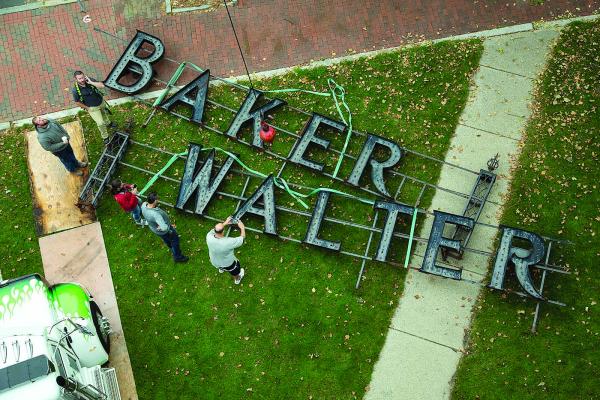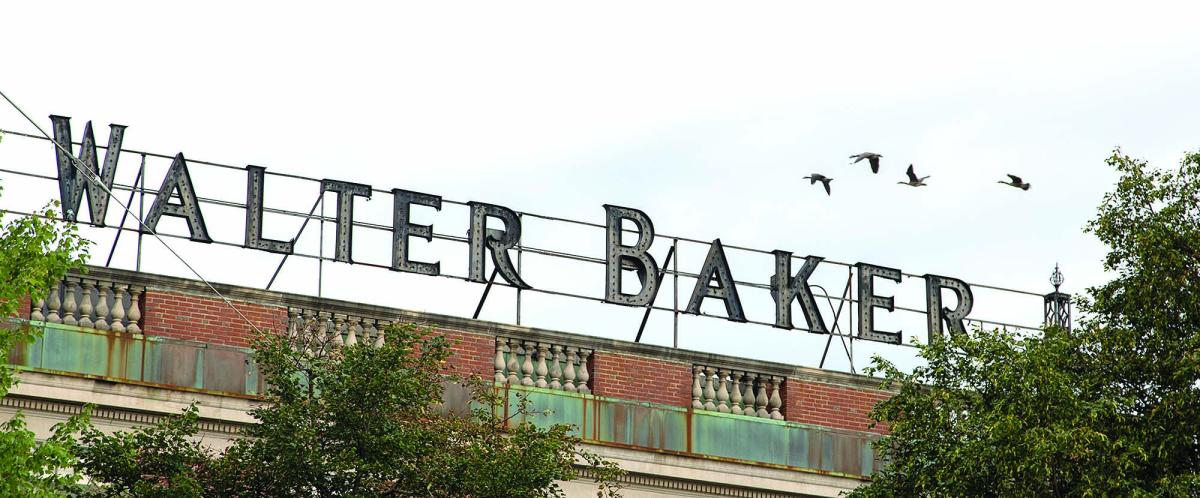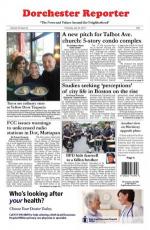December 16, 2021

Until it was taken down last month in a nod to irreparable decay, the Walter Baker neon sign had towered over Lower Mills for nearly a century, standing tall even after the eponymous chocolate factory closed 56 years ago, leaving hundreds jobless and the buildings empty.
Blacked out since 1965, the sign remained firmly in place as the old complex, with its administrative offices and mill buildings intact, was transformed into a sprawling residential village through which the Neponset River, as always, made its way to Boston Harbor.
Now, while a new sign is being welded out of aluminum and relighted, there’s an ongoing discussion locally about the fate of the original letters.
“Once we knew they couldn’t all be fixed, we started to focus on the question of what to do with these very large, kind of rotted out, but fascinating, 100-year-old letters?” said Terry Dolan, a 30-year resident of the Baker complex, the secretary/treasurer of the Lower Mills Civic Association, and one of the community leaders behind the restoration project.
After reaching out to donors who have helped to fund the work and talking with residents, Dolan said the response to preserving the old letters has been enthusiastic. There are countless ideas for what to do with them, she added.
When the sign was removed, Catherine Infantino, office administrator at New Atlantic Development, the construction manager for the project, was approached by a number of individuals who were curious about what would happen with the remains.
“We’ve definitely gotten interest from people,” she told the Reporter. “We’ll take [things] under advisement to see what makes the most sense.”
For her part, Dolan has reached out to half a dozen people who donated over a thousand dollars to the relighting project and asked if they would like to acquire one or more of the letters, which range from four to five feet tall, in return for their donations.
Time will tell what happens with that approach and interest from others with ideas, but Dolan says that in the end, if the letters aren’t all scooped up, she will reach out to the Dorchester Arts Collaborative and the Dorchester Art Project to see if they might be willing to take the letters and consider using them creatively with Dorchester-based artists.
“They’re kind of rusty. They’re kind of strange looking. But they’re pieces of art,” she said.
Another Baker Chocolate Company condo resident, David Stokle, would like to see the old letters repurposed in some way.
“I’d hate for them to just go to nothing when they could preserve some history,” said the artist, photographer, and sculptor who lives in an apartment below where the sign had sat since 1919.
While his plan is tentative – he has to acquire the letters first and assess their condition – Stokle is thinking of what he describes as a totem pole design featuring a vertical sculpture that starts off stacking letters turned on their sides and mirroring each other—two As, two Es, and two Rs—almost resembling a person, he said. At the top of the two As, which Stokle described as the arms of the figure, would sit the “T” in “Walter,” flipped to resemble a head or top hat. The design would then switch from this symmetrical pattern to a staggering of the remaining letters along the bottom half of the pole.

“I’d hate for them to just go to nothing when they could preserve some history,” says Walter Baker Lofts resident David Stokle, who captured images of the vintage signage as it was dismantled on Nov. 10. Stokle is among those who would like the old letters to be re-purposed.
Earl Taylor, president of the Dorchester Historical Society, said using the letters in an art installation like Stokle’s design would help to tell part of Dorchester’s history. “If they were just the letters, they probably wouldn’t be of much interest,” he said. “But to use them in a new installation would bring attention to them” in a positive way.
Ultimately, Dolan and the Lower Mills Association along with New Atlantic Development will have the final say in what’s done with the letters.
Dolan has a lifelong connection to the factory complex; she grew up less than a mile away from it.
From 1765 until 1965, the Baker Chocolate Company was a booming cocoa business, until its owner, the Postum Cereal Co., moved the operation to Delaware.
But the neighborhood started to revive in the 1980s as the conversion of factory space into apartments began in earnest. By 2010, more than 200 condominiums and apartments had been opened across the fetch of the factory’s uniform rust-colored brick buildings. Since then, dozens of small businesses have taken their places in the surrounding neighborhood and residents have come and gone, just like the factory. All the while, the Walter Baker sign, though in daylight only, sent out a clear message that a man named Walter Baker had made history in the Lower Mills section of Dorchester.
Many who lived that history, like Susan Coffey, a nurse at Carney Hospital and a member of the Milton Historical Society, recall the days when the factory was alive with workers. After living in Florida for a few years, Coffey returned to Dorchester last year and moved into one of the Baker Chocolate apartments, citing the complex’s history, architecture, and her own roots in the community as the reasons for her choice of living space.
Looking out her window at where the Walter Baker sign was, Coffey, 65, talked of the smell of chocolate from the factory that overspread the south end of Dorchester depending on weather patterns.
“It’s almost a rite of passage,” she said. “If you ask anyone in my age group who grew up here ‘what do you remember about Lower Mills?’ the answer was ‘the smell of the chocolate.’”
Coffey, who supports plans to repurpose the old letters, said, “To be honest, I would love to get one of them. To just toss them would be terrible. People need to remember the history, and that’s just all part of it.”




